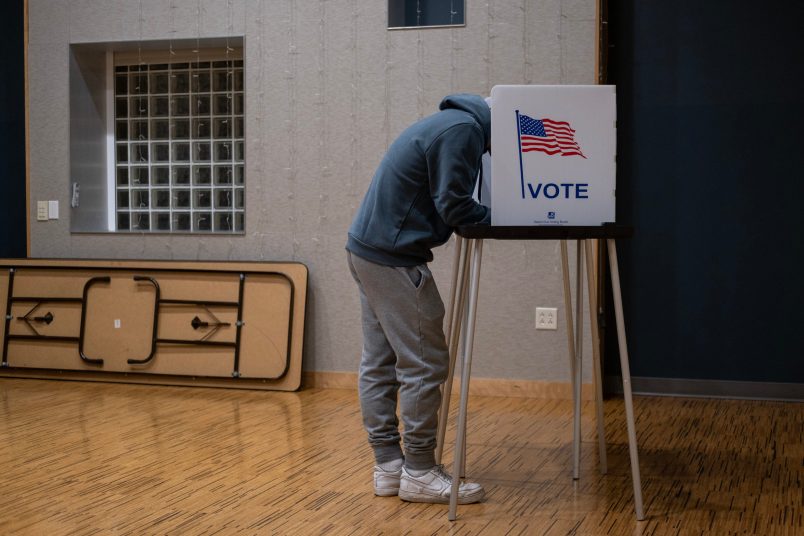On Tuesday, Wisconsin voters will head to the polls for the primary in a state Supreme Court election that could have a huge influence on the state’s future. The top two vote getters — including, potentially, two candidates of the same ideological bent — will move on to the April 4 general election.
The election gives liberals the chance to take back the majority on the court for the first time in about 15 years, an opportunity made all the more significant given that the court is expected to hear big-ticket cases on abortion access, redistricting and, potentially, election disputes in 2024.
Republicans, who, thanks to years of gerrymandering enjoy an overwhelming majority in the state legislature despite the even split of statewide races, added to the ballot a few extra incentives for their voters come the general election.
Two of the ballot initiatives would amend the state constitution to allow judges to take a person’s criminal history into account while setting bail — which would likely make it harder for some defendants to get out of jail. The other is a nonbinding advisory question, which asks voters to weigh in on whether low-income people should have to perform job searches to receive “tax-payer funded welfare benefits.” Wisconsin already requires people receiving unemployment insurance to do so, though Republicans have suggested they’d like to see the requirement extended to those who receive Medicaid.
State Democrats, incensed, tried to counter with a referendum of their own, seeking to get a question on the ballot to gauge voters’ interest in seeing a near-complete abortion ban dating from 1849 — currently pending before a lower state court — repealed. The Republican majority summarily smacked them down.
The ballot measures are a win-win for Republicans: They may draw out voters for the sleepy Supreme Court election, and those voters already inclined to come out are also more inclined to support Republicans.
“Off year elections’ electorates tend to be older, whiter and more conservative — so it’s less about turnout and more about the legislature having the discretion to put these issues on ballots where these kinds of voters turn out,” Gina Moore, the Senior Manager for the Ballot Initiative Strategy Center’s Defend Direct Democracy campaign, told TPM.
This Republican gambit may still be thwarted.
A group advocating for formerly incarcerated people and its parent social justice network sued the Wisconsin Election Commission and its commissioners, arguing that the resolutions were not filed with county clerks in accordance with the deadline dictated by law, and are therefore barred from appearing on the April 4 ballot.
“While the Legislature may have filed the Resolutions with the Wisconsin Elections Commission before the 70–day deadline, the Resolutions were not filed with the county clerks or [Milwaukee County Board of Election Commissioners], who are the actual filing officers, until January 26, 2023,” the groups wrote. “It follows that the Resolutions were not timely filed and therefore that they do not qualify for inclusion on the ballot for the April 4, 2023 Spring Election.”
Dane County Circuit Court Judge Rhonda Lanford said she’ll issue a decision on the case by the close of business on Monday, the day before the primary.
This Republican tactic, of pinning on ballot initiatives — specifically nonbinding ballot initiatives — as a bonus for their voters, is fairly unusual on the state level, though it’s very common on local ballots, said Robert Yablon, associate professor of law and faculty co-director of the State Democracy Research Initiative at the University of Wisconsin-Madison.
“This is the first the state has had since 2006, and that was a November election,” Yablon told TPM. “This is the first time it’s been in an April election in about 30 years.”
It comes at a time when ballot initiatives, particularly to amend state constitutions, are getting more attention than ever before after a 2022 cycle when voters in even deeply red states turned out at the polls to vote for abortion access, or at least against restriction.
These are not quite that — the state Supreme Court race is clearly still the main event. Slapping these small measures on the ballot seems to be calculated to try to get a few more people out, given the low turnout expectations.
“I recognize that people want to pull out all the stops in what might be a very close election,” Yablon said. “But I am skeptical that these ballot measures will make much of a difference — it’s hard to imagine that many voters out there would not be motivated to show up for a very high stakes Supreme Court election where many millions of dollars are invested, and yet it would be the presence of bail reform on the ballot or a nonbinding referendum about welfare that would get them out.”
One side effect of the initiatives could be to frame the adjoining Supreme Court race around issues Republicans see as better for their cause.
“Voters are prompted in some way to think about issues like crime and welfare rather than issues more progressive candidates would want them focused on, like abortion and gerrymandering,” Yablon said.



